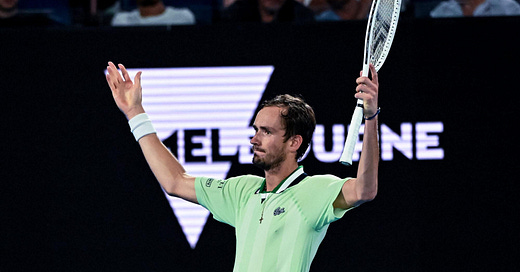What Would Happen If Men’s Tennis Grand Slams Were Best-of-3?
Want to introduce some chaos into a competition that’s often too predictable? This oughta do it.
When Rafael Nadal trailed Daniil Medvedev two sets to none in the 2022 Australian Open final, he knew he needed to make every shot count if he was going to pull off a comeback for the ages. So, point by point, that’s exactly what Nadal did as he chipped away at Medvedev’s lead, ultimately winning the marathon match to claim what was then a men’s record 21st grand slam title.
But if the men’s grand slams were played under the same rules as the women, that would never have happened.
Let me explain: Every WTA event — and almost all ATP ones, too — play a best-of-3 format, where two set victories are all it takes to walk away with the match. But in the men’s grand slams, matches are extended to 3-out-of-5, giving more chances for players who fall behind early to mount a huge comeback like the one Nadal pulled off.
But what would happen if everything was equalized, and the men’s slams were best-of-3 as well? How much would it change things? To find the answer, I looked at grand slam results from the past three seasons using data from the incredible Tennis Abstract. (Note: I excluded retirements and walkovers.) For every matchup, we can create a hypothetical scenario under which the first player to two set victories also wins the match, and track how often that would flip the result from the actual, real-life winner.
Overall, only one of about every nine matches would flip winners if the men played best-of-3 instead of best-of-5. The vast majority of matches (80%) are concluded in either three or four sets anyway, and it’s impossible for the eventual winners there to not also win at least two of the first three sets in a real-life best-of-5.
But what’s fascinating is what happens when we isolate only those matches which went the full five sets in reality. Of those, the eventual winner was ahead through three sets only 45% percent of the time — meaning 55% percent of matches that took five sets to sort out would have had a different winner if they’d stopped playing after somebody won two of them.
That percentage dips a little bit when we filter out early rounds of tournaments and/or matches that aren’t as competitive. The flip rate for matches between two players ranked among the world’s top 50 was exactly 50% (i.e., the eventual winner was ahead 37 times through three sets in 74 chances), and it dropped to 45% for matches in the Round of 16 or later.
This suggests that some of the effect might be due to better players pacing themselves against lesser competition — a psychological factor that admittedly isn’t accounted for in our hypotheticals. It is very likely that players would strategize differently if they knew they had to win 2-of-3 sets rather than 3-of-5.
But even so, it's an argument that close matches between great players could be made even more unpredictable with a change in format.
We're not the first ones to make this suggestion, of course. It's long been a debate in tennis, with the other side taken up by traditionalists such as former world No. 3 Dominic Thiem, who said this when asked about best-of-5 sets at the grand slams in 2020:
“The way it is now, it’s perfect. I think majors should stay best-of-five. It’s tradition. It’s the way it always was, and it makes it very special.”
There's something to be said for that. And there's a reason great players seem to be relatively split on the matter. But as other sports (such as baseball) tinker with a quicker game as well, perhaps Novak Djokovic put it best in a 2020 press conference:
“Yes, I am more of a proponent of best-of-three sets everywhere … I just feel like the attention span as well of the fans, especially the younger generation, is shorter. So in order for us to really improve the product, so to say, of tennis, you know, I think commercially and marketing-wise I feel like we have to adapt to that younger generation.”
While less of a grueling test, best-of-3 would make for a faster-paced product. And the number of close matchups that would potentially end up going the opposite way, depending on match length, suggests that shortening men’s grand slam matches to mirror what the women play — and what the men play most of the time anyway — would introduce some chaos into a sport that often bemoans its lack of parity.
After all, a shorter match would represent a smaller sample — which we know would make the underdog more likely to win, even if it also makes epic comebacks like Nadal’s impossible.
Filed under: Tennis
Original story: We Asked: What Would Happen If Men’s Tennis Grand Slams Were Best-of-3?






Nice Neil!
This from Twenty First Group is worth reading if you haven’t already on the same topic from a different angle (“The three set format in the women’s game has also limited the narrative value of Williams’ success and therefore the connection that fans have with Williams and the women’s game”):
https://www.twentyfirstgroup.com/three-sets-mean-serena-not-novak-is-the-goat/